Non-Zero Dispersion-Shifted Fiber
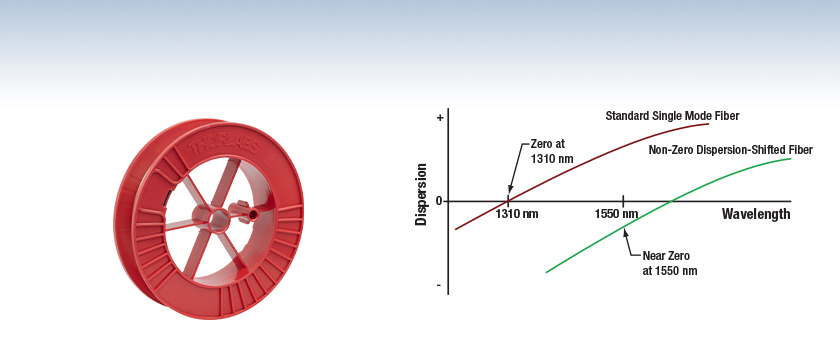
- Dispersion: -4.0 ps/nm•km at 1550 nm
- SM Fiber with Low Attenuation
- For Applications in the C-Band (1530 - 1565 nm)
DCF4
In DCF4 Fiber, the zero-dispersion wavelength is shifted to near 1550 nm for low-loss and low-dispersion operation in the C-band. The drawing above is for illustrative purposes only.

Please Wait
| Specificationsa | |
|---|---|
| Dispersion Specificationsb,c | |
| Dispersion | -4.0 ps/nm•km |
| Dispersion Slope | 0.12 ps/nm2•km |
| Polarization Mode Dispersion | ≤0.1 ps/√km |
| General Specifications | |
| Operating Wavelength | 1530 - 1565 nm (C-Band) |
| Mode Field Diameterc | 8.85 to 9.60 µm |
| Effective Areac | 65 µm2 |
| Cladding Diameter | 125.0 ± 1.0 µm |
| Coating Diameter | 250 ± 5 µm |
| Coating-Cladding Concentricity | <12 µm |
| Core-Clad Concentricity | ≤0.5 µm |
| Cutoff Wavelength | ≤1500 nm |
| Attenuationc | ≤0.210 dB/km |
| Optical Return Loss | ≥60 dB |
Features
- For Applications in the C-Band (1530 - 1565 nm)
- Dispersion: -4.0 ps/nm•km at 1550 nm
- Attenuation: ≤0.210 dB/km at 1550 nm
Applications
- Telecommunications
- Dispersion Management
- Wavelength-Division Multiplexing
Thorlabs' DCF4 Non-Zero Dispersion-Shifted Fiber offers low attenuation and near-zero dispersion performance from 1530 nm to 1565 nm (C-band). Compared to standard single mode fibers, DCF4 fiber features a low negative dispersion of -4.0 ps/nm•km at 1550 nm that allows it to be used alone as an effective solution to dispersion problems over short or medium lengths of fiber. For systems with more stringent dispersion requirements at 1550 nm, the dispersion from DCF4 fiber can be compensated using shorter lengths of other fibers that have large positive dispersion at 1550 nm, such as our SMF-28-J9.
As the zero-dispersion wavelength is shifted outside of the C-band, four-wave mixing effects are minimized over the operating range of our DCF4 fiber (see the Dispersion Tutorial tab for more information). The large effective area of 65 µm2 allows the fiber to carry signals with high optical power without significant non-linear effects.
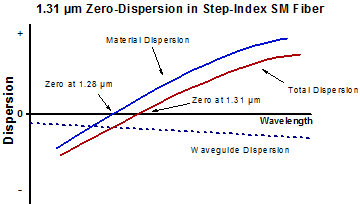
Click to Enlarge
Figure 2.1 Waveguide dispersion offsets chromatic dispersion to produce zero dispersion at 1.31 µm in step-index SM fiber.
Dispersion in Optical Fiber
Chromatic dispersion is a property of optical fiber where different wavelengths of light propagate at different velocities. Chromatic dispersion is a function of wavelength, and is defined as the sum of the material and waveguide dispersion. Material dispersion arises from the change in a material's refractive index with wavelength, which changes the propagation velocity of light as a function of wavelength.
Waveguide dispersion is a separate effect arising from the geometry of the fiber optic waveguide. Waveguide properties are a function of wavelength; consequently, changing the wavelength affects how light is guided in a single mode fiber as a change in the distribution of light in the cladding and core. Chromatic dispersion can be defined as:
Dispersionchromatic(λ) = Dispersionmaterial(λ) + Dispersionwaveguide(λ)
Since material and waveguide dispersion are wavelength dependent, the dispersion is a function of wavelength. The dispersion slope, defined as dD/dλ, can be positive, negative, or zero.
As seen in Figure 2.1, for standard step-index single mode fiber, the sum of the material and waveguide dispersion is zero near 1310 nm, which makes 1310 nm the zero-dispersion wavelength (ZDW).
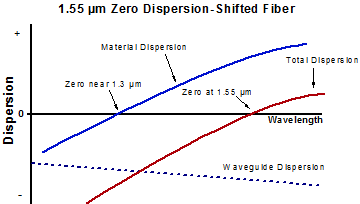
Click to Enlarge
Figure 2.2 A fiber designed with more waveguide dispersion shifts the zero-dispersion wavelength to 1.55 µm.
Dispersion-Shifted Fiber
For standard step-index single mode fiber, the zero-dispersion wavelength is near 1310 nm. By modifying the fiber's waveguide structure, the waveguide dispersion can be shifted up or down, thus shifting the ZDW toward longer or shorter wavelengths, as seen in Figure 2.2. Typically, if the ZDW is shifted to 1550 nm, the fiber is called dispersion-shifted fiber.
Non-Zero Dispersion-Shifted Fiber
Shifting the ZDW to 1550 nm is not always the best strategy. When multiple optical channels pass through the same fiber at wavelengths where dispersion is very close to zero, they suffer from a type of crosstalk called four-wave mixing. The degradation is so severe that dispersion-shifted fiber cannot be used for dense wavelength-division multiplexing (WDM) systems. To avoid four-wave mixing, the ZDW is moved outside the transmission band, as seen in Figure 2.3. Fibers with this property and a low, but non-zero dispersion in the C-band, are called non-zero dispersion-shifted fibers. Although dispersion is minimized, it is still present.
Thorlabs offers DCF4 fiber as a non-zero dispersion-shifted fiber for a number of applications, including WDM systems. While not its primary purpose, DCF4 fiber can also be integrated into systems as a way to compensate for unwanted dispersion.
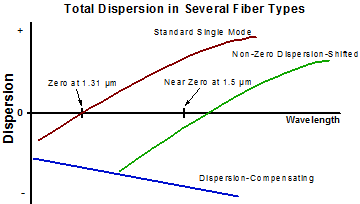
Click to Enlarge
Figure 2.3 Only total dispersion is shown in this graph.
Dispersion-Compensating Fiber
Since dispersion is inevitable in optical fibers, dispersion-compensating fibers can be incorporated into optical systems to cancel out or compensate the dispersion of a standard single mode fiber. These fibers have a large negative chromatic dispersion greater than that of standard single mode fiber. A negative dispersion slope enables effective cancellation of dispersion over a larger wavelength range, since the dispersion slope of standard fiber is usually positive. Generally, a short length of dispersion-compensating fiber is spliced onto a longer length of standard fiber to compensate for dispersion. Because they have positive dispersion slope and relatively small dispersion at the target wavelength, non-zero dispersion-shifted fibers are not true dispersion-compensating fibers.
| Quick Links |
|---|
| Damage at the Air / Glass Interface |
| Intrinsic Damage Threshold |
| Preparation and Handling of Optical Fibers |
Laser-Induced Damage in Silica Optical Fibers
The following tutorial details damage mechanisms relevant to unterminated (bare) fiber, terminated optical fiber, and other fiber components from laser light sources. These mechanisms include damage that occurs at the air / glass interface (when free-space coupling or when using connectors) and in the optical fiber itself. A fiber component, such as a bare fiber, patch cable, or fused coupler, may have multiple potential avenues for damage (e.g., connectors, fiber end faces, and the device itself). The maximum power that a fiber can handle will always be limited by the lowest limit of any of these damage mechanisms.
While the damage threshold can be estimated using scaling relations and general rules, absolute damage thresholds in optical fibers are very application dependent and user specific. Users can use this guide to estimate a safe power level that minimizes the risk of damage. Following all appropriate preparation and handling guidelines, users should be able to operate a fiber component up to the specified maximum power level; if no maximum is specified for a component, users should abide by the "practical safe level" described below for safe operation of the component. Factors that can reduce power handling and cause damage to a fiber component include, but are not limited to, misalignment during fiber coupling, contamination of the fiber end face, or imperfections in the fiber itself. For further discussion about an optical fiber’s power handling abilities for a specific application, please contact Thorlabs’ Tech Support.
Damage at the Air / Glass Interface
There are several potential damage mechanisms that can occur at the air / glass interface. Light is incident on this interface when free-space coupling or when two fibers are mated using optical connectors. High-intensity light can damage the end face leading to reduced power handling and permanent damage to the fiber. For fibers terminated with optical connectors where the connectors are fixed to the fiber ends using epoxy, the heat generated by high-intensity light can burn the epoxy and leave residues on the fiber facet directly in the beam path.
| Table 36C Estimated Optical Power Densities on Air / Glass Interfacea | ||
|---|---|---|
| Type | Theoretical Damage Thresholdb | Practical Safe Levelc |
| CW (Average Power) |
~1 MW/cm2 | ~250 kW/cm2 |
| 10 ns Pulsed (Peak Power) |
~5 GW/cm2 | ~1 GW/cm2 |
Damage Mechanisms on the Bare Fiber End Face
Damage mechanisms on a fiber end face can be modeled similarly to bulk optics, and industry-standard damage thresholds for UV Fused Silica substrates can be applied to silica-based fiber. However, unlike bulk optics, the relevant surface areas and beam diameters involved at the air / glass interface of an optical fiber are very small, particularly for coupling into single mode (SM) fiber. therefore, for a given power density, the power incident on the fiber needs to be lower for a smaller beam diameter.
Table 36C lists two thresholds for optical power densities: a theoretical damage threshold and a "practical safe level". In general, the theoretical damage threshold represents the estimated maximum power density that can be incident on the fiber end face without risking damage with very good fiber end face and coupling conditions. The "practical safe level" power density represents minimal risk of fiber damage. Operating a fiber or component beyond the practical safe level is possible, but users must follow the appropriate handling instructions and verify performance at low powers prior to use.
Calculating the Effective Area for Single Mode Fibers
The effective area for single mode (SM) fiber is defined by the mode field diameter (MFD), which is the cross-sectional area through which light propagates in the fiber; this area includes the fiber core and also a portion of the cladding. To achieve good efficiency when coupling into a single mode fiber, the diameter of the input beam must match the MFD of the fiber.
As an example, SM400 single mode fiber has a mode field diameter (MFD) of ~Ø3 µm operating at 400 nm, while the MFD for SMF-28 Ultra single mode fiber operating at 1550 nm is Ø10.5 µm. The effective area for these fibers can be calculated as follows:
SM400 Fiber: Area = Pi x (MFD/2)2 = Pi x (1.5 µm)2 = 7.07 µm2 = 7.07 x 10-8 cm2
SMF-28 Ultra Fiber: Area = Pi x (MFD/2)2 = Pi x (5.25 µm)2 = 86.6 µm2 = 8.66 x 10-7 cm2
To estimate the power level that a fiber facet can handle, the power density is multiplied by the effective area. Please note that this calculation assumes a uniform intensity profile, but most laser beams exhibit a Gaussian-like shape within single mode fiber, resulting in a higher power density at the center of the beam compared to the edges. Therefore, these calculations will slightly overestimate the power corresponding to the damage threshold or the practical safe level. Using the estimated power densities assuming a CW light source, we can determine the corresponding power levels as:
SM400 Fiber: 7.07 x 10-8 cm2 x 1 MW/cm2 = 7.1 x 10-8 MW = 71 mW (Theoretical Damage Threshold)
7.07 x 10-8 cm2 x 250 kW/cm2 = 1.8 x 10-5 kW = 18 mW (Practical Safe Level)
SMF-28 Ultra Fiber: 8.66 x 10-7 cm2 x 1 MW/cm2 = 8.7 x 10-7 MW = 870 mW (Theoretical Damage Threshold)
8.66 x 10-7 cm2 x 250 kW/cm2 = 2.1 x 10-4 kW = 210 mW (Practical Safe Level)
Effective Area of Multimode Fibers
The effective area of a multimode (MM) fiber is defined by the core diameter, which is typically far larger than the MFD of an SM fiber. For optimal coupling, Thorlabs recommends focusing a beam to a spot roughly 70 - 80% of the core diameter. The larger effective area of MM fibers lowers the power density on the fiber end face, allowing higher optical powers (typically on the order of kilowatts) to be coupled into multimode fiber without damage.
Damage Mechanisms Related to Ferrule / Connector Termination
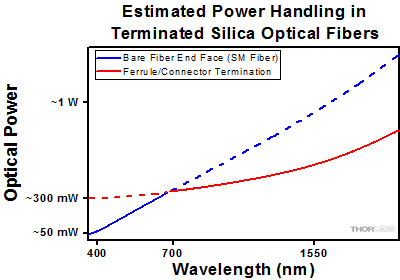 Click to Enlarge
Click to EnlargeFigure 36D Plot showing approximate input power that can be incident on a single mode silica optical fiber with a termination. Each line shows the estimated power level due to a specific damage mechanism. The maximum power handling is limited by the lowest power level from all relevant damage mechanisms (indicated by a solid line).
Fibers terminated with optical connectors have additional power handling considerations. Fiber is typically terminated using epoxy to bond the fiber to a ceramic or steel ferrule. When light is coupled into the fiber through a connector, light that does not enter the core and propagate down the fiber is scattered into the outer layers of the fiber, into the ferrule, and the epoxy used to hold the fiber in the ferrule. If the light is intense enough, it can burn the epoxy, causing it to vaporize and deposit a residue on the face of the connector. This results in localized absorption sites on the fiber end face that reduce coupling efficiency and increase scattering, causing further damage.
For several reasons, epoxy-related damage is dependent on the wavelength. In general, light scatters more strongly at short wavelengths than at longer wavelengths. Misalignment when coupling is also more likely due to the small MFD of short-wavelength SM fiber that also produces more scattered light.
To minimize the risk of burning the epoxy, fiber connectors can be constructed to have an epoxy-free air gap between the optical fiber and ferrule near the fiber end face. Our high-power multimode fiber patch cables use connectors with this design feature.
Determining Power Handling with Multiple Damage Mechanisms
When fiber cables or components have multiple avenues for damage (e.g., fiber patch cables), the maximum power handling is always limited by the lowest damage threshold that is relevant to the fiber component. In general, this represents the highest input power that can be incident on the patch cable end face and not the coupled output power.
As an illustrative example, Figure 36D shows an estimate of the power handling limitations of a single mode fiber patch cable due to damage to the fiber end face and damage via an optical connector. The total input power handling of a terminated fiber at a given wavelength is limited by the lower of the two limitations at any given wavelength (indicated by the solid lines). A single mode fiber operating at around 488 nm is primarily limited by damage to the fiber end face (blue solid line), but fibers operating at 1550 nm are limited by damage to the optical connector (red solid line).
In the case of a multimode fiber, the effective mode area is defined by the core diameter, which is larger than the effective mode area for SM fiber. This results in a lower power density on the fiber end face and allows higher optical powers (on the order of kilowatts) to be coupled into the fiber without damage (not shown in graph). However, the damage limit of the ferrule / connector termination remains unchanged and as a result, the maximum power handling for a multimode fiber is limited by the ferrule and connector termination.
Please note that these are rough estimates of power levels where damage is very unlikely with proper handling and alignment procedures. It is worth noting that optical fibers are frequently used at power levels above those described here. However, these applications typically require expert users and testing at lower powers first to minimize risk of damage. Even still, optical fiber components should be considered a consumable lab supply if used at high power levels.
Intrinsic Damage Threshold
In addition to damage mechanisms at the air / glass interface, optical fibers also display power handling limitations due to damage mechanisms within the optical fiber itself. These limitations will affect all fiber components as they are intrinsic to the fiber itself. Two categories of damage within the fiber are damage from bend losses and damage from photodarkening.
Bend Losses
Bend losses occur when a fiber is bent to a point where light traveling in the core is incident on the core/cladding interface at an angle higher than the critical angle, making total internal reflection impossible. Under these circumstances, light escapes the fiber, often in a localized area. The light escaping the fiber typically has a high power density, which burns the fiber coating as well as any surrounding furcation tubing.
A special category of optical fiber, called double-clad fiber, can reduce the risk of bend-loss damage by allowing the fiber’s cladding (2nd layer) to also function as a waveguide in addition to the core. By making the critical angle of the cladding/coating interface higher than the critical angle of the core/clad interface, light that escapes the core is loosely confined within the cladding. It will then leak out over a distance of centimeters or meters instead of at one localized spot within the fiber, minimizing the risk of damage. Thorlabs manufactures and sells 0.22 NA double-clad multimode fiber, which boasts very high, megawatt range power handling.
Photodarkening
A second damage mechanism, called photodarkening or solarization, can occur in fibers used with ultraviolet or short-wavelength visible light, particularly those with germanium-doped cores. Fibers used at these wavelengths will experience increased attenuation over time. The mechanism that causes photodarkening is largely unknown, but several fiber designs have been developed to mitigate it. For example, fibers with a very low hydroxyl ion (OH) content have been found to resist photodarkening and using other dopants, such as fluorine, can also reduce photodarkening.
Even with the above strategies in place, all fibers eventually experience photodarkening when used with UV or short-wavelength light, and thus, fibers used at these wavelengths should be considered consumables.
Preparation and Handling of Optical Fibers
General Cleaning and Operation Guidelines
These general cleaning and operation guidelines are recommended for all fiber optic products. Users should still follow specific guidelines for an individual product as outlined in the support documentation or manual. Damage threshold calculations only apply when all appropriate cleaning and handling procedures are followed.
-
All light sources should be turned off prior to installing or integrating optical fibers (terminated or bare). This ensures that focused beams of light are not incident on fragile parts of the connector or fiber, which can possibly cause damage.
-
The power-handling capability of an optical fiber is directly linked to the quality of the fiber/connector end face. Always inspect the fiber end prior to connecting the fiber to an optical system. The fiber end face should be clean and clear of dirt and other contaminants that can cause scattering of coupled light. Bare fiber should be cleaved prior to use and users should inspect the fiber end to ensure a good quality cleave is achieved.
-
If an optical fiber is to be spliced into the optical system, users should first verify that the splice is of good quality at a low optical power prior to high-power use. Poor splice quality may increase light scattering at the splice interface, which can be a source of fiber damage.
-
Users should use low power when aligning the system and optimizing coupling; this minimizes exposure of other parts of the fiber (other than the core) to light. Damage from scattered light can occur if a high power beam is focused on the cladding, coating, or connector.
Tips for Using Fiber at Higher Optical Power
Optical fibers and fiber components should generally be operated within safe power level limits, but under ideal conditions (very good optical alignment and very clean optical end faces), the power handling of a fiber component may be increased. Users must verify the performance and stability of a fiber component within their system prior to increasing input or output power and follow all necessary safety and operation instructions. The tips below are useful suggestions when considering increasing optical power in an optical fiber or component.
-
Splicing a fiber component into a system using a fiber splicer can increase power handling as it minimizes possibility of air/fiber interface damage. Users should follow all appropriate guidelines to prepare and make a high-quality fiber splice. Poor splices can lead to scattering or regions of highly localized heat at the splice interface that can damage the fiber.
-
After connecting the fiber or component, the system should be tested and aligned using a light source at low power. The system power can be ramped up slowly to the desired output power while periodically verifying all components are properly aligned and that coupling efficiency is not changing with respect to optical launch power.
-
Bend losses that result from sharply bending a fiber can cause light to leak from the fiber in the stressed area. When operating at high power, the localized heating that can occur when a large amount of light escapes a small localized area (the stressed region) can damage the fiber. Avoid disturbing or accidently bending fibers during operation to minimize bend losses.
-
Users should always choose the appropriate optical fiber for a given application. For example, large-mode-area fibers are a good alternative to standard single mode fibers in high-power applications as they provide good beam quality with a larger MFD, decreasing the power density on the air/fiber interface.
-
Step-index silica single mode fibers are normally not used for ultraviolet light or high-peak-power pulsed applications due to the high spatial power densities associated with these applications.
| Posted Comments: | |
perter lee
(posted 2022-11-23 14:16:33.707) what is dispersion at wavelength 1030 nm?
Is there dispersion curve(v.s wavelength) of this fiber?
any information of dispersion is helpful!thanks! jgreschler
(posted 2022-11-23 10:55:21.0) Thank you for reaching out to Thorlabs. Additional data and specs can be requested by contacting techsupport@thorlabs.com. I have reached out to you directly to discuss this application. Tobias Tieß
(posted 2022-02-16 02:15:28.39) I have just received 50m of DCF4 fiber. I checked the spec sheets and i didnt find any information on whether this fiber is also complying to any ITU-T Telecommunication Norm of G.655 standard. Do you have any information on that?
Thanks and BR
Tobias cdolbashian
(posted 2022-02-18 05:03:59.0) Thank you for reaching out to us Tobias. After looking into the ITU guidelines which outline requirements for G.655 standards, it appears that the DCF4 does not satisfy a few of the requirements. I have reached out to you directly to discuss possible alternatives. Lawrence Trask
(posted 2021-06-03 17:14:11.083) Hi, I was wondering if this DCF was doped with fluorine or not. Or if typical splice loss to SMF28 is known. YLohia
(posted 2021-06-04 02:25:03.0) Hello, thank you for contacting Thorlabs. We have performed several splices between the DCF4 and SMF-28 and the estimated splice loss was within the industry standard of <0.1 dB. Please note that the actual splice loss will depend on the settings for the alignment accuracy in the splicer, so we cannot provide a formal spec for this due to the variables outside our control. I have reached out to you directly to discuss the doping. Shailendra Varshney
(posted 2019-11-01 08:56:55.367) Could you please share the dispersion data of NZ-DSF as it is needed to decide on the the fiber YLohia
(posted 2019-11-01 10:29:13.0) The dispersion and dispersion slope values at 1550nm are given in the specsheet. Using this, the dispersion in the 1530 - 1565 nm range can be estimated. Hee Su Park
(posted 2019-10-08 12:59:00.14) Do you have measurement results of the group refractive index of DCF4? In addition, what is the zero-dispersion wavelength of DCF4? Is it 1518.3 nm (calculated from the numbers in the datasheet)? YLohia
(posted 2019-10-15 10:25:48.0) Hello, thank you for contacting Thorlabs. The effective index of refraction is 1.4690. The zero dispersion wavelength will be 1550 nm + (Dispersion @ 1550nm)/(Dispersion slope @ 1550nm) = 1583.33 nm. Please note that the dispersion and the slope values are typical, so the zero dispersion wavelength could vary. |
 Products Home
Products Home













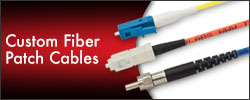
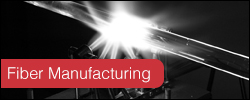
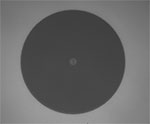
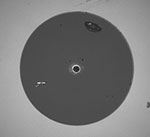

 Non-Zero Dispersion-Shifted Fiber
Non-Zero Dispersion-Shifted Fiber